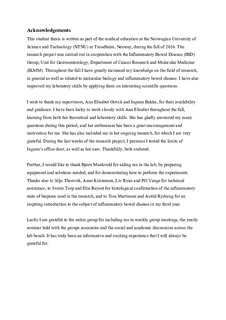| dc.description.abstract | Background: Inflammatory bowel disease (IBD) is a collective term for the two entities, ulcerative colitis (UC) and Crohn’s disease (CD). They are both characterized by a relapsing inflammation causing destruction of the intestinal tissue, and thereby causing severe gastrointestinal and systemic symptoms. Environmental, genetic, microbial and immunologic factors all contribute in the pathological process. Smoking is one of the best known environmental factors having an impact on the acquisition and evolvement of both UC and CD. IBD affects approximately 2.4 million Europeans, with the highest incidence found in Northern Europe. In Norway, the overall incidence rate for IBD is approximately 20 per 100,000 inhabitants, making it a considerable burden both for the patient and the society.
Objectives: The IBD research group at St. Olav’s hospital has explored the gene expression in colonic biopsies from patients with IBD, as well as gene expression in ileal biopsies from patients with CD. The protein peroxisome proliferator-activated receptor gamma (PPARγ) was among the downregulated genes, when comparing active disease vs. healthy controls. In this study, the expression of PPARγ on both protein- and mRNA-level was further investigated in colonic biopsies from patients with active and inactive IBD. The protein expression of PPARγ was also investigated in ileal biopsies from patients with active and inactive CD. Healthy controls were used for comparison. Further, intestinal epithelial cells treated with pioglitazone/5-aminosalicylic acid (5-ASA), or cultured in cigarette smoke (CS) conditioned medium, was studied to explore the effect of PPARγ ligands and CS on the release of the chemotactic cytokines CXCL10/IP-10 and CXCL8/IL-8.
Materials and methods: Expression of PPARγ was explored by immunohistochemistry (IHC) and in situ hybridization (ISH) on colonic biopsies from five different patient groups: active UC, inactive UC, active CD, inactive CD and healthy controls. Expression of PPARγ was explored by IHC on ileal biopsies from three different patient groups: active CD, inactive CD and healthy controls. Release of CXCL10 and CXCL8 from the colorectal adenocarcinoma cell line HT-29 was explored in harvested supernatant, by enzyme-linked immunosorbent assay (ELISA). The cells were treated with PPARγ ligands pioglitazone and 5-ASA, or cultured in CS conditioned medium, prior to stimulation with the pattern recognition receptor ligands flagellin and polyinosinic:polycyticylic acid (poly(I:C)), and the pro-inflammatory cytokines TNFα and IL-1β.
Results: By IHC, we found that PPARγ was mainly detected in the nucleus of the epithelial cells in the colon, and in the cytoplasm of the epithelial cells in the ileum. A few cells residing in the lamina propria showed positive cytoplasmic staining in both colon and ileum. The mRNA expression in the colonic tissue was localized to the epithelial cells, with scattered positive staining in cells residing in the lamina propria, confirming the results found by IHC. The expression of PPARγ in the colonic mucosa seemed to be reduced in active disease, compared to healthy controls and inactive disease. Both protein and mRNA expression was most prominent at the luminal surface, with decreasing expression towards the crypt bases. IL-1β, TNFα and poly(I:C) significantly induced CXCL8 release from HT-29 cells, whilst only poly(I:C) and TNFα significantly induced CXCL10 release. When the HT-29 cells were cultured in CS-conditioned medium, TNFa stimulated release of CXCL8 and poly(I:C) stimulated release of CXCL10 was significantly attenuated. Treatment with pioglitazone caused a significant reduction of poly(I:C) stimulated CXCL10 release. Treatment with 5- ASA caused a significant, dose-dependent reduction of poly(I:C) stimulated release of both CXCL8 and CXCL10. A dose-dependent reduction of CXCL8 release was also observed in TNFα stimulated cells treated with 5-ASA.
Conclusion: Both the protein and the mRNA expression of PPARγ was primarily detected in the epithelial lining, most prominently in the upper half of the crypt and in the cells facing the intestinal lumen. In the colon, the protein was detected in the epithelial cell nuclei, whilst in the ileum, the epithelial staining was primarily cytoplasmic. PPARɣ ligands pioglitazone and 5-ASA significantly reduced the release of the chemotactic cytokines CXCL8 and CXCL10 in stimulated intestinal epithelial cells. Low concentrations of CS affected the release of both CXCL8 and CXCL10 in HT-29 cells stimulated with pro-inflammatory factors. The results presented here are preliminary findings and the experiments must be repeated. | nb_NO |
